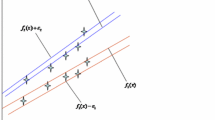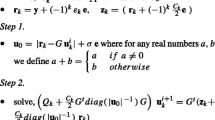Abstract
This paper presents an efficient ν-Twin Support Vector Machine Based Regression Model with Automatic Accuracy Control (ν-TWSVR). This ν-TWSVR model is motivated by the celebrated ν-SVR model (Schlkoff et al. 1998) and recently introduced 𝜖-TSVR model (Shao et al., Neural Comput Applic 23(1):175–185, 2013). The ν-TSVR model can automatically optimize the parameters 𝜖 1 and 𝜖 2 according to the structure of the data such that at most certain specified fraction ν 1(respectively ν 2) of data points contribute to the errors in up (respectively down) bound regressor. The ν-TWSVR formulation constructs a pair of optimization problems which are mathematically derived from a related ν-TWSVM formulation (Peng, Neural Netw 23(3):365–372, 2010) and making use of an important result of Bi and Bennett (Neurocomputing 55(1):79–108, 2003). The experimental results on artificial and UCI benchmark datasets show the efficacy of the proposed model in practice.








Similar content being viewed by others
References
Burges JC (1998) A tutorial on support vector machines for pattern recognition. Data Min Knowl Disc 2 (2):121–167
Cortes C, Vapnik V (1995) Support vector networks. Mach Learn 20(3):273–297
Bradley P, Mangasarian OL (2000) Massive data discrimination via linear support vector machines. Optim Methods Softw 13(1):1–10
Cherkassky V, Mulier F (2007) Learning from data: concepts, theory and methods. Wiley, New York
Bi J, Bennett KP (2003) A geometric approach to support vector regression. Neurocomputing 55(1):79–108
Jayadeva, Khemchandani R, Chandra S (2007) Twin support vector machines for pattern classification. IEEE Trans Pattern Anal Mach Intell 29(5):905–910
Peng X (2010) TSVR: an efficient twin support vector machine for regression. Neural Netw 23(3):365–372
Khemchandani R, Goyal K, Chandra S (2016) TWSVR: regression via twin support vector machine. Neural Netw 74:14–21
Shao YH, Zhang C, Yang Z, Deng N (2013) An 𝜖-twin support vector machine for regression. Neural Comput & Applic 23(1):175–185
Schölkopf B, Bartlett P, Smola AJ, Williamson RC (1998) Support vector regression with automatic accuracy control. In: ICANN, vol 98. Springer, London, pp 111–116
Peng X (2010) A ν-twin support vector machine (ν-TSVM) classifier and its geometric algorithms. Inf Sci 180(20):3863–3875
Schölkopf B, Smola AJ, Williamson RC, Bartlett PL (2000) New support vector algorithms. Neural Comput 12(5):1207–1245
Blake CI, Merz CJ (1998) UCI repository for machine learning databases, http://www.ics.uci.edu/*mlearn/MLRepository.html
Xu Y, Wang L (2014) K-nearest neighbor-based weighted twin support vector regression. Appl Intell 41 (1):299–309
Vapnik V (1998) Statistical learning theory, vol 1. Wiley, New York
Acknowledgments
The authors are extremely thankful to the learned referees whose valuable comments have helped to improve the content and presentation of the paper.
Author information
Authors and Affiliations
Corresponding author
Appendices
Appendix A
Proposition 1
Suppose ν-TWSVR is applied on a dataset which results 𝜖 1 (respectively 𝜖 2 ) > 0, then following statements hold.
-
(a)
v 1 (respectively v 2 ) is an upper bound on fraction of error ξ(respectively η).
-
(b)
v 1 (respectively v 2 ) is a lower bound on fraction of support vectors for up bound (respectively down bound) regressor.
Proof
-
(a)
Using the KKT conditions (21) and (25) for up bound regressor, we can find that for ξ i > 0, β i = 0 and \(\alpha _{i} = \frac {c_{2}}{l}\). Since from (22) and (26), e T α≤c 2 v 1, so there may exist at most l v 1 points for which ξ i ≠0. In the similar way using the K.K.T. optimality conditions for down bound regressor we can prove that there are at most l v 2 points for which η i ≠0.
-
(b)
Using the KKT conditions (22) and (25) for 𝜖 1≠0 we find that γ = 0. This implies that e T α = c 2 v 1.
Since \(0 \leq \alpha _{i} \leq \frac {c_{2}}{l} \) so there must be at least l v 1 points for which α i ≠0. In similar way using the K.K.T conditions for down bound regressor we can prove that there are at least l v 2 points for which λ i ≠0 .
□
Appendix B: ν-TWSVR via ν-TWSVM
Bi and Bennett [5] have shown the equivalence between a given regression problem and an appropriately constructed classification problem. They have shown that for a given regression training set (A,Y), a regressor y = w T x + b is an 𝜖-insensitive regressor if and only if the set D + and D − locate on different sides of n+1 dimensional hyperplane w T x−y + b = 0 respectively where
In veiw of this result of Bi and Bennett [5], the regression problem is equivalent to the classification problem of sets D + and D − in R n+1. If we use the TWSVM methodology [6] for the classification of these two sets D + and D − then we can find TWSVM based Regression [8]. It is relevant to mention here that the classification of set D + and D − is a special case of classification where we have following privilege informations.
-
(a)
D + and D − classes are symmetric in nature and have equal number of sample points.
-
(b)
Points in the class D + and D − are separated by the distance 2𝜖.
These privileged informations must be exploited for the better classification as better classification of the set D + and D − will eventually lead to better regressor. The classification of the set D + and D − in R n+1 using ν-TWSVM results into following QPPs
and
Let us first consider the problem (40). Here we note that η 1≠0 and therefore, without loss of generality, we can assume that η 1 > 0. The constraint of (40) can be rewriteen as
On replacing w 1:=−w 1/η 1, b 1:=−b 1/η 1 and noting that η 1≥0, (40) reduces to
Next, if we replace e b 1: = e b 1−𝜖 e in (42) then it reduces to
Let \(\left (2e\epsilon -\frac {\rho _{+}}{\eta _{1}}\right ):=e\epsilon _{1}\) then it will reduce to
In the similar manner, assuming η 2 > 0 and using the replacement w 2:=−w 2/η 2, b 2:=−b 2/η 2, problem (41) can be written as
If we replace e b 2: = e b 2 + 𝜖 e and \((2e\epsilon -\frac {\rho _{-}}{\eta _{2}}):=e\epsilon _{2}\) then problems reduces to
Looking at problems (44) and (45 ) we observe that our approach is valid provided we can show that \(\epsilon _{1}=(2\epsilon -\frac {2\rho _{+}}{\eta _{1}}) \geq 0\) and \(\epsilon _{2} = (2\epsilon -\frac {2\rho _{-}}{\eta _{2}}) \geq 0\). We can prove this assertion as follow.
As the first hyperplane w T x + η 1 y + b 1 = 0 is the least square fit for the class D + so there certainly exists an index j such that
Also from (40),
In particular, taking (47) for j we get
Adding (47) and (48) we get \(\epsilon _{1} = \left (2\epsilon -\frac {\rho _{+}}{\eta _{1}}\right ) \geq 0\). Similarly we can prove that \(\epsilon _{2} = \left (2\epsilon -\frac {\rho _{-}}{\eta _{2}}\right ) \geq 0\).
Remark 2
The above proof can be appropriately modified to show that 𝜖-TSVR formulation of Shao et al. [9] also follows from Bi and Bennett [5] results and TWSVM methodology.
Rights and permissions
About this article
Cite this article
Rastogi, R., Anand, P. & Chandra, S. A ν-twin support vector machine based regression with automatic accuracy control. Appl Intell 46, 670–683 (2017). https://doi.org/10.1007/s10489-016-0860-5
Published:
Issue Date:
DOI: https://doi.org/10.1007/s10489-016-0860-5




